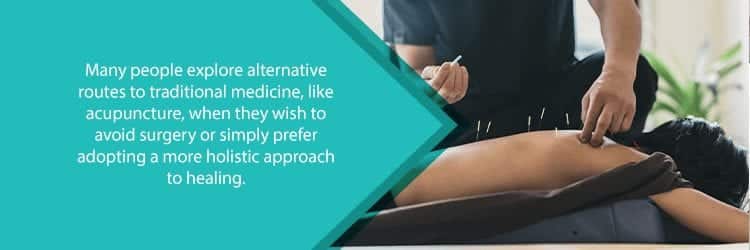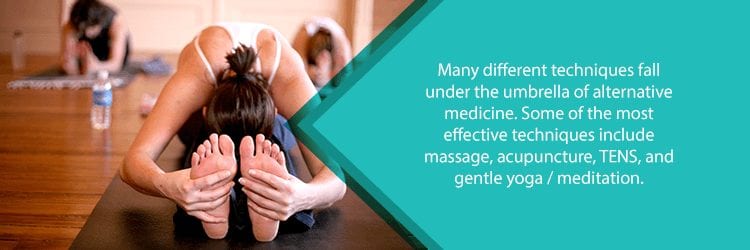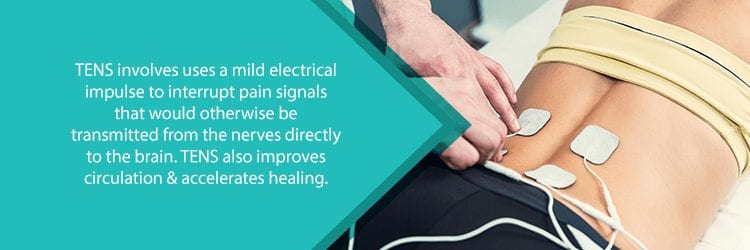Suffering from back pain can severely limit how you live your life. While resting the area and pain medications may be helpful in the short-term, you know that you’ll need a more permanent solution. Luckily, there are many different back pain treatments. While some methods are straightforward medical procedures, others come from more “alternative” origins.
Moreover, some people who struggle with chronic back pain are reluctant to choose surgery. They may fear “going under the knife” or wish to avoid all the hassles of the recovery period. This, among other reasons, motivates these people to search for other solutions.
Alternative therapies may be the answer for symptom relief and addressing the conditions that cause you pain. Of course, it’s hard to sift through all the therapies out there. While some have evidence-based results, others may be a little more “experiential” or lacking in scientific research.
Remember, the internet is full of claims. You don’t want to waste time, money, and even the risk of making your back pain worse by relying on an unsubstantiated claim. Use this guide to understand your back pain and some alternative therapies with documented positive results. In fact, some of these alternative therapies have been in use for centuries.

What Causes Back Pain?
If you suffer from back pain, you are certainly not alone. According to the National Institute of Neurological Disorders and Stroke, up to 80% of adults experience back pain at some point in their lives. In fact, both men and women suffer from this condition, which can range from mild discomfort to debilitating pain.
Many people experience back pain because of sprains and strains in the soft tissues of their backs. Athletes and those with labor-intensive jobs often feel the pain in their muscles, ligaments, and tendons. Heavy lifting, repetitive movements, and overstretching all put excessive strain on the back.
Of course, this is not the only cause of back pain. Sometimes structural damage to the spine because of aging or injuries leads to chronic back pain. For example, when the discs that support and protect your vertebrae dry out and lose shape, it can cause severe back pain. Sometimes known as degenerative disc disease, this condition can also lead to a herniated disc. This occurs when the gel-like inside of a disc ruptures outside of its fibrous container. As a result, a ruptured disc can apply pressure on nearby nerves.
Inflammation to the joints and osteoporosis can also affect the back. Likewise, a narrowing of the spinal canalknown as spinal stenosis—can put pressure on the nerves, leading to back pain, numbness, and muscle weakness.
What are Alternative Therapies?
You’ve probably heard the term “alternative therapy” even if you aren’t sure exactly what it means. In Western culture, we are conditioned to believe that a doctor holds the answers to all of our problems. Pain medications, surgical procedures, and medical protocols are often the norm.
Of course, modern medicine isn’t the only option. The modern view of treating back pain puts blinders on our abilities to explore other, more non-traditional opportunities. After all, generations of other cultures have also developed ways to help with back pain. Some alternative therapies can be considered complementary or integrative—meaning, they are used in conjunction with Western medicine. Other techniques may function as a substitute when traditional medicine doesn’t seem to help.
So why don’t some alternative therapies have as much scientific backing? Sadly, it is often due to funding. Most trials for conventional therapies are funded by big companies that develop medications and other medical equipment. Sadly, alternative therapies don’t have the financial support to research large, controlled medical studies.
Should this keep you from trying alternative therapy? The answer is ultimately up to you. Of course, researching alternative therapies and discussing them with your doctor is a great way to make informed decisions. However, stay away from therapies that offer “too good to be true” claims.

Which Alternative Therapies Are Best for Back Pain?
Are you ready to explore new ways to help with your back pain? Here are some options that others like you have found to be helpful—even, life-changing. Of course, you may still want to consult with your doctor before trying any of these alternative therapies. While most are relatively safe and have few side effects, you don’t want to risk making your back pain even worse.
Massage Therapy
You probably know that a massage can help to ease tension and help you to feel more relaxed. In fact, a trained massage therapist can actually perform certain techniques that zero in on helping those who are dealing with back pain. Since many issues with the back involve muscle or other soft tissue injuries, a massage can be a great non-invasive way to help you feel better. A massage therapist can relieve muscle tension while also improving flexibility and blood circulation to affected areas. In addition, a massage releases the “feel good” chemicals—known as endorphins—that ease emotions like stress, depression, and anxiety. Negative emotions affect the body and can cause more muscle tension, making back pain even worse.
A massage is great for muscle strains in the back, but it can also help with other conditions. For example, those dealing with spinal arthritis can benefit from a massage by improving circulation and reducing inflammation. In addition, those with fibromyalgia can get relief from general and localized stiffness, fatigue, and pain during a massage.
Acupuncture or Acupressure
In some Eastern cultures, it is believed a blockage of Chi or Q—an energy that runs throughout your body—leads to physical illnesses including back pain. By focusing on the channels that distribute Chi, one can experience pain relief and a better biochemical balance. For some, this is a more ideal alternative to strong or habit-forming pain medications.
Acupuncture uses very fine needles that a practitioner inserts into specific points in the body, depending on your conditions and symptoms. Your body begins responding while you’re lying comfortably with these needles at certain meridians for a half hour or so. How? These needles stimulate the nervous system, which releases endorphins and other chemicals to the muscles, brain, and spinal cord. Studies have shown that acupuncture helps with some forms of lower back pain as well as with osteoarthritis and tension headaches.
A little leery of sticking needles in your body? Using the same Chi principles as acupuncture, acupressure involves applying pressure to sensitive areas of the body where Chi may be blocked. A qualified acupressure specialist will use fingers, thumbs, and even elbows to target the meridians in the body. The benefits for back pain are similar to acupuncture.
Transcutaneous Electrical Nerve Stimulation (TENS)
Your nervous system uses electrical impulses to send messages to and from the brain. By using a TENS unit, certain pain impulses can be disrupted and temporarily suspended by using mild shocks of electricity. This may help those with tendonitis, arthritis, bursitis, muscle injuries, and other conditions that cause back pain.
How does it work? Electrodes are applied to areas on your skin near the affected region. The power unit then delivers electrical currents to the body. This can improve circulation, aid in the recovery process, and block pain signals from the nerves to the brain.
While you may think “electrocuting” yourself is painful, remember these are mild electrical currents. You will probably only experience a light tingling or buzzing sensation. In fact, you may even find using a TENS unit to be relaxing.

Yoga
Yoga isn’t just for “fit” people who love to wear tight workout gear. In fact, it can be a great way to alleviate your back pain. And don’t worry, you don’t have to contort yourself into a human pretzel to get relief.
Yoga is a form of moving meditation that involves focusing on your breath while performing certain postures. This aids in relaxation, flexibility, mobility, and reducing muscle tension and stiffness. Many of the postures are adaptable to any fitness level. As you get better at these postures, you can challenge yourself to stretch more and longer. In fact, there are some yoga classes specifically designed for those who suffer from back pain.
Ready to Get Help for Your Back Pain?
Are you sick of dealing with your back pain? Do you want answers how to finally get your life back? NJ Spine & Orthopedic is ready to help. Our doctors believe conservative treatments, including alternative therapies, are a great way to start treating certain back conditions. Our team will guide you to make informed decisions on the best treatments available to help you live your life pain-free.
If conservative treatments don’t seem to help, we specialize in minimally invasive procedures, which lead to less pain after surgery and faster recovery times. It’s time to start feeling better. Why not use every tool available to help you get your life back? NJ Spine & Orthopedic is ready to discuss the best treatments for you. Call us at (855) 586-2615.

